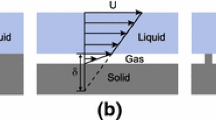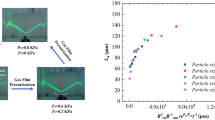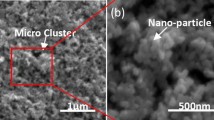Abstract
The biomimetic hydrophobic surface is a potentially efficient underwater drag reduction method and the drag reduction mechanism of this kind of surface comes from the interfacial slippage. For now, it is a hotspot to grasp the slippage characteristic and explore slippage enhancement strategies. This paper not only summarizes our numerical simulation and experimental results of slippage characteristic at the solid-liquid interface (SLI) of hydrophobic surfaces (HS) and the gas-liquid interface (GLI) of superhydrophobic surfaces (SHS) in recent years, but also introduces some innovative methods that can effectively improve the gas film stability and drag reduction effect of SHS. First, we used the molecular dynamics (MD) simulation method to figure out the effect of the solid-liquid interaction strength, the system temperature and the shear rate on the slippage of SLI, and expound their action mechanism from molecular scale. Then, by MD and multibody dissipative particle dynamics (MDPD) method, the slippage behavior at the GLI was studied under the influence of the microstructure size and the flow driving velocity. We proposed a new kind of hybrid slip boundary condition model to describe the slippage characteristic on GLI. In addition, we found through experiment that a three-dimensional backflow will appear on the GLI under the interfacial adsorption of surfactants, and the backflow direction will reverse with the change of GLI morphology. Finally, we put forward the wettability step structure and gas injection method to enhance the stability and drag reduction effect of the gas film on SHS.
Similar content being viewed by others
References
Mäkiharju S. A., Perlin M., Ceccio S L. On the energy economics of air lubrication drag reduction [J]. International Journal of Naval Architecture and Ocean Engineering, 2012, 4(4): 412–422.
Neinhuis W. B. Purity of the sacred lotus, or escape from contamination in biological surfaces [J]. Planta, 1997, 202(1): 1–8.
Zuo Y., Zheng L., Zhao C. et al. Micro-/nanostructured interface for liquid manipulation and its applications [J]. Small, 2020, 16(9): 1903849.
Samaha M. A., Gad-El-Hak M. Slippery surfaces: A decade of progress [J]. Physics of Fluids, 2021, 33(7): 071301.
Tian G., Zhang Y., Feng X. et al. Focus on bioinspired textured surfaces toward fluid drag reduction: Recent progresses and challenges [J]. Advanced Engineering Materials, 2022, 24(1): 2100696.
Rothstein J. P. Slip on superhydrophobic surfaces [J]. Annual Review of Fluid Mechanics, 2009, 42(1): 89–109.
Lee C., Choi C. H., Kim C. J. Superhydrophobic drag reduction in laminar flows: A critical review [J]. Experiments in Fluids, 2016, 57(12): 176.
Park H., Choi C. H., Kim C. J. Superhydrophobic drag reduction in turbulent flows: A critical review [J]. Experiments in Fluids, 2021, 62(11): 229.
Voronov R. S., Papavassiliou D. V., Lee L. L. Slip length and contact angle over hydrophobic surfaces [J]. Chemical Physics Letters, 2007, 441(4–6): 273–276.
Priezjev N. V. Rate-dependent slip boundary conditions for simple fluids [J]. Physical Review E, 2007, 75(5): 051605.
Xie J. F., Cao B. Y. Influence of travelling surface waves on nanofluidic viscosity [J]. Computers and Fluids, 2018, 160: 42–50.
Liu C., Li Z. Flow regimes and parameter dependence in nanochannel flows [J]. Physical Review E, 2009, 80(3): 036302.
Liu C., Li Z. Surface effects on nanoscale Poiseuille flows under large driving force [J]. Journal of Chemical Physics, 2010, 132(2): 024507.
Teisala H., Butt H. J. Hierarchical structures for superhydrophobic and superoleophobic surfaces [J]. Langmuir, 2019, 35(33): 10689–10703.
Wen J., Hu H. B., Luo Z. Z. et al. Experimental investigation of flow past a circular cylinder with hydrophobic coating [J]. Journal of Hydrodynamics, 2018, 30(6): 992–1000.
Ou J., Rothstein J. P. Direct velocity measurements of the flow past drag-reducing ultrahydrophobic surfaces [J]. Physics of Fluids, 2005, 17(10): 103606.
Ybert C., Barentin C., Cottin-Bizonne C. et al. Achieving large slip with superhydrophobic surfaces: Scaling laws for generic geometries [J]. Physics of Fluids, 2007, 19(12): 123601.
Schmieschek S., Belyaev A. V., Harting J. et al. Tensorial slip of superhydrophobic channels [J]. Physical Review E, 2012, 85(1): 016324.
Schönecker C., Baier T., Hardt S. Influence of the enclosed fluid on the flow over a microstructured surface in the Cassie state [J]. Journal of Fluid Mechanics, 2014, 740: 168–195.
Schäffel D., Koynov K., Vollmer D. et al. Local flow field and slip length of superhydrophobic surfaces [J]. Physical Review Letters, 2016, 116(13): 134501.
Huang S., Lv P., Duan H. Morphology evolution of liquid–gas interface on submerged solid structured surfaces [J]. Extreme Mechanics Letters, 2019, 27: 34–51.
Mehanna Y. A., Sadler E., Upton R. L. et al. The challenges, achievements and applications of submersible superhydrophobic materials [J]. Chemical Society Reviews, 2021, 50(11): 6569–6612.
Gaard E., Andersen N. K., Smistrup K. et al. Study of transitions between wetting states on microcavity arrays by optical transmission microscopy [J]. Langmuir, 2014, 30(43): 12960.
Seo J., García-Mayoral R., Mani A. Pressure fluctuations and interfacial robustness in turbulent flows over superhydrophobic surfaces [J]. Journal of Fluid Mechanics, 2015, 783: 448–473.
Hemeda A. A., H Vahedi T. General formulations for predicting longevity of submerged superhydrophobic surfaces composed of pores or posts [J]. Langmuir, 2014, 30(34): 10317–10327.
Choi W., Byeon H., Park J. Y. et al. Effects of pressure gradient on stability and drag reduction of superhydrophobic surfaces [J]. Applied Physics Letters, 2019, 114(10): 101603.
Lv P., Xiang Y., Xue Y. et al. Morphological bubble evolution induced by air diffusion on submerged hydrophobic structures [J]. Physics of Fluids, 2017, 29(3): 032001.
Xiang Y., Huang S., Lv P. et al. Ultimate stable underwater superhydrophobic state [J]. Physical Review Letters, 2017, 119(13): 134501.
Ling H., Katz J., Fu M. et al. Effect of Reynolds number and saturation level on gas diffusion in and out of a superhydrophobic surface [J]. Physical Review Fluids, 2017, 2(12): 124005.
Xiang Y., Xue Y., Lv P. et al. Influence of fluid flow on the stability and wetting transition of submerged superhydrophobic surfaces [J]. Soft Matter, 2016, 12(18): 4241–4246.
Bao L., Priezjev N. V., Hu H. et al. Effects of viscous heating and wall-fluid interaction energy on rate-dependent slip behavior of simple fluids [J]. Physical Review E, 2017, 96(3): 033110.
Hu H., Bao L., Priezjev N. V. et al. Identifying two regimes of slip of simple fluids over smooth surfaces with weak and strong wall-fluid interaction energies [J]. Journal of Chemical Physics, 2017, 146(3): 034701.
Wang F. C., Zhao Y. P. Slip boundary conditions based on molecular kinetic theory: The critical shear stress and the energy dissipation at the liquid-solid interface [J]. Soft Matter, 2011, 7(18): 8628–8634.
Lichter S., Martini A., Snurr R. Q. et al. Liquid slip in nanoscale channels as a rate process [J]. Physical Review Letters, 2007, 98(22): 226001.
Bao L., Hu H., Wen J. et al. Three-dimensional structure of a simple liquid at a face-centered-cubic (001) solid surface interface [J]. Scientific Reports, 2016, 6(1): 29786.
Thompson P. A., Robbins M. O. Shear-flow near solids-epitaxial order and flow boundary-conditions [J]. Physical Review A, 1990, 41(12): 6830–6837.
Ou J., Perot B., Rothstein J. P. Laminar drag reduction in microchannels using ultrahydrophobic surfaces [J]. Physics of Fluids, 2004, 16(12): 4635–4643.
Bao L., Priezjev N. V., Hu H. The local slip length and flow fields over nanostructured superhydrophobic surfaces [J]. International Journal of Multiphase Flow, 2020, 126: 103258.
Song D., Daniello R. J., Rothstein J. P. Drag reduction using superhydrophobic sanded Teflon surfaces [J]. Experiments in Fluids, 2014, 55(8): 1783.
Ren L., Hu H., Bao L. et al. Many-body dissipative particle dynamics study of the local slippage over superhydrophobic surfaces [J]. Physics of Fluids, 2021, 33(7): 072001.
Gao P., Feng J. J. Enhanced slip on a patterned substrate due to depinning of contact line [J]. Physics of Fluids, 2009, 21(10): 102102.
Aljallis E., Sarshar M. A., Datla R. et al. Experimental study of skin friction drag reduction on superhydrophobic flat plates in high Reynolds number boundary layer flow [J]. Physics of Fluids, 2013, 25(2): 025103.
Xu M., Yu N., Kim J. et al. Superhydrophobic drag reduction in high-speed towing tank [J]. Journal of Fluid Mechanics, 2020, 908: A6.
Hu H., Wang D., Ren F. et al. A comparative analysis of the effective and local slip lengths for liquid flows over a trapped nanobubble [J]. International Journal of Multiphase Flow, 2018, 104: 166–173.
Peaudecerf F. J., Landel J. R., Goldstein R. E. et al. Traces of surfactants can severely limit the drag reduction of superhydrophobic surfaces [J]. Proceedings of the National Academy of Sciences, 2017, 114(28): 7254.
Landel J. R., Peaudecerf F. J., Temprano-Coleto F. et al. A theory for the slip and drag of superhydrophobic surfaces with surfactant [J]. Journal of Fluid Mechanics, 2020, 883: A18.
Li H., Li Z., Tan X. et al. Three-dimensional backflow at liquid-gas interface induced by surfactant [J]. Journal of Fluid Mechanics, 2020, 899: A8.
Baier T., Hardt S. Influence of insoluble surfactants on shear flow over a surface in Cassie state at large Péclet numbers [J]. Journal of Fluid Mechanics, 2021, 907: A3.
Tomlinson S. D., Gibou F., Luzzatto-Fegiz P. et al. Laminar drag reduction in surfactant-contaminated superhydrophobic channels [J]. Journal of Fluid Mechanics, 2023, 963: A10.
Song D., Song B., Hu H. et al. Effect of a surface tension gradient on the slip flow along a superhydrophobic air-water interface [J]. Physical Review Fluids, 2018, 3(3): 033303.
Hu H., Wen J., Bao L. et al. Significant and stable drag reduction with air rings confined by alternated superhydrophobic and hydrophilic strips [J]. Science Advances, 2017, 3(9): e1603288.
Zhang M., Hu H., Wen J. et al. Controlling the morphology and slippage of the air-water interface on superhydrophobic surfaces [J]. Experiments in Fluids, 2023, 64(6): 121.
Du P., Wen J., Zhang Z. et al. Maintenance of air layer and drag reduction on superhydrophobic surface [J]. Ocean Engineering, 2017, 130: 328–335.
Acknowledgements
This work was supported by the Shenzhen Science and Technology Program (Grant No. JCYJ20210324122201004), the Qinchuangyuan high-level innovative and entrepreneurial talents introduction plan (Grant No. QCYRCXM-2022-125).
Author information
Authors and Affiliations
Corresponding author
Ethics declarations
Conflict of interest: The authors declare that they have no conflict of interest. Hai-bao Hu, Jun Wen and Luo Xie are editorial board members for the Journal of Hydrodynamics and was not involved in the editorial review, or the decision to publish this article. All authors declare that there are no other competing interests.
Ethical approval: This article does not contain any studies with human participants or animals performed by any of the authors.
Informed consent: Not applicable.
Additional information
Project supported by the National Natural Science Foundation of China (Grant Nos. 52071272, 52201382 and 12102358).
Biography: Meng-zhuo Zhang (1996-), Male, Ph. D. Candidate
Rights and permissions
About this article
Cite this article
Zhang, Mz., Hu, Hb., Ren, Lz. et al. Research progress of slippage characteristic and gas film stability enhancement methods on biomimetic hydrophobic surfaces. J Hydrodyn 36, 87–101 (2024). https://doi.org/10.1007/s42241-024-0004-z
Received:
Revised:
Accepted:
Published:
Issue Date:
DOI: https://doi.org/10.1007/s42241-024-0004-z




